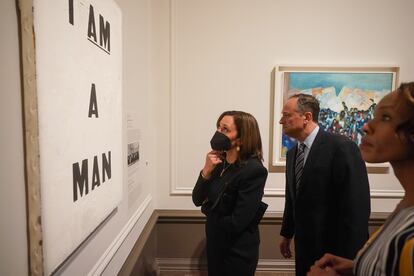National Gallery’s landmark ‘Afro-Atlantic Histories’ closes to critical success
The exploration of long-ignored contributions to art also attracted record crowds to the DC museum, including Vice-President Kamala Harris who called it ‘historic’


Like everyone else, the people in charge of Washington’s National Gallery of Art thought they had to come out of the pandemic doing better than they did before it. So, when the federal capital’s formidable art museum reopened in the spring of 2021, after a long year of being closed, its leadership set the goal of diversifying its discourse. The museum, like the rest of the country, suddenly awakened in the Black Lives Matter era with a lot of racial reckoning to do.
Among other measures, the museum hired Kanitra Fletcher as the associate curator of African American and Afro-Diaspora art. She is tasked with ensuring that Black art is represented at the venerable institution. She is also the curator of the US tour of the “Afro-Atlantic Histories” exhibition, which comes from the Museu de arte de São Paulo, where it made a splash in 2018. The exhibit’s stay in Washington ended this weekend as a great success with critics and the public alike: according to National Gallery estimates, “Afro-Atlantic Histories” has received some 140,000 visitors, making it “one of the exhibits that has generated the most interest in recent years.”

Vice President Kamala Harris, the first woman and the first person of color to hold that position in the United States, attended the exhibit. She celebrated the “historic occasion” during her visit to “Afro-Atlantic Histories.” “And it is, precisely, because this is a story that is rarely heard in our schools or displayed in our museums,” she told the National Gallery’s director, Kaywin Feldman, the first woman to head the museum in its eight-decade history. This exhibit was the first project that was completely Feldman’s own since she assumed the post in 2019.
The exhibit aimed to rethink the history of the diaspora of enslaved persons and its social and cultural consequences through 130 works of art and documents from the 17th century to the present, which originated in Africa, the Americas, and Europe.

In São Paulo, the exhibition was more extensive. Fletcher—who was previously at the Museum of Fine Arts in Houston, where the exhibit has also been on display—worked to adapt the art show to each place’s circumstances. “In Washington, for example, we have given special prominence to the works that were in our collection, and that, in some cases, have recently been acquired with the idea of making the National Gallery more diverse,” the curator explained in a telephone conversation. Among the new acquisitions are Puerto Rican artist Daniel Lind-Ramos’s sculpture “Figura de poder” (Power Figure, 2017), and the piece “Ntozahke II, (Parktown)” (2016), a photographic mural from Zanele Muholi’s digital archive, the self-portrait that has made the South African artist a ubiquitous presence in the city in recent months.

Another recent acquisition, American artist Hank Willis Thomas’s “A Place to Call Home (Africa America Reflection)”—a two-meter-high stainless-steel map—welcomes visitors to “Afro-Atlantic Histories” and to a continent where Africa and North America unite at Panama’s latitude. In that same room, a 1789 slave ship plan sets the tone for the exhibit’s discourse in which everything—eras and media—is mixed, and contemporary art comingles with eighteenth-century Creole canvases and paintings by African American modernists, including Alma Thomas, Jacob Lawrence and Aaron Daniels.
The result offers a transnational vision of the Black American experience. It complements the readings of the recently inaugurated National Museum of African American History and Culture, the only Smithsonian institution where the visitor must make a reservation to guarantee access (they all have free admission), and the 1619 Project, which rethinks the starting point of United States history, changing it from 1776 to the year the first slave arrived at Point Fort, Virginia (located some 300 kilometers from the National Gallery). The “Afro-Atlantic Histories” exhibition that ended on Sunday in Washington also makes the case for reconsidering that matter.
Tu suscripción se está usando en otro dispositivo
¿Quieres añadir otro usuario a tu suscripción?
Si continúas leyendo en este dispositivo, no se podrá leer en el otro.
FlechaTu suscripción se está usando en otro dispositivo y solo puedes acceder a EL PAÍS desde un dispositivo a la vez.
Si quieres compartir tu cuenta, cambia tu suscripción a la modalidad Premium, así podrás añadir otro usuario. Cada uno accederá con su propia cuenta de email, lo que os permitirá personalizar vuestra experiencia en EL PAÍS.
¿Tienes una suscripción de empresa? Accede aquí para contratar más cuentas.
En el caso de no saber quién está usando tu cuenta, te recomendamos cambiar tu contraseña aquí.
Si decides continuar compartiendo tu cuenta, este mensaje se mostrará en tu dispositivo y en el de la otra persona que está usando tu cuenta de forma indefinida, afectando a tu experiencia de lectura. Puedes consultar aquí los términos y condiciones de la suscripción digital.
More information
Archived In
Últimas noticias
Most viewed
- David King, chemist: ‘There are scientists studying how to cool the planet; nobody should stop these experiments from happening’
- Reinhard Genzel, Nobel laureate in physics: ‘One-minute videos will never give you the truth’
- Mexico completes its trade shift with the entry into force of tariffs on China and countries without trade agreements
- Oona Chaplin: ‘I told James Cameron that I was living in a treehouse and starting a permaculture project with a friend’
- Sinaloa Cartel war is taking its toll on Los Chapitos










































